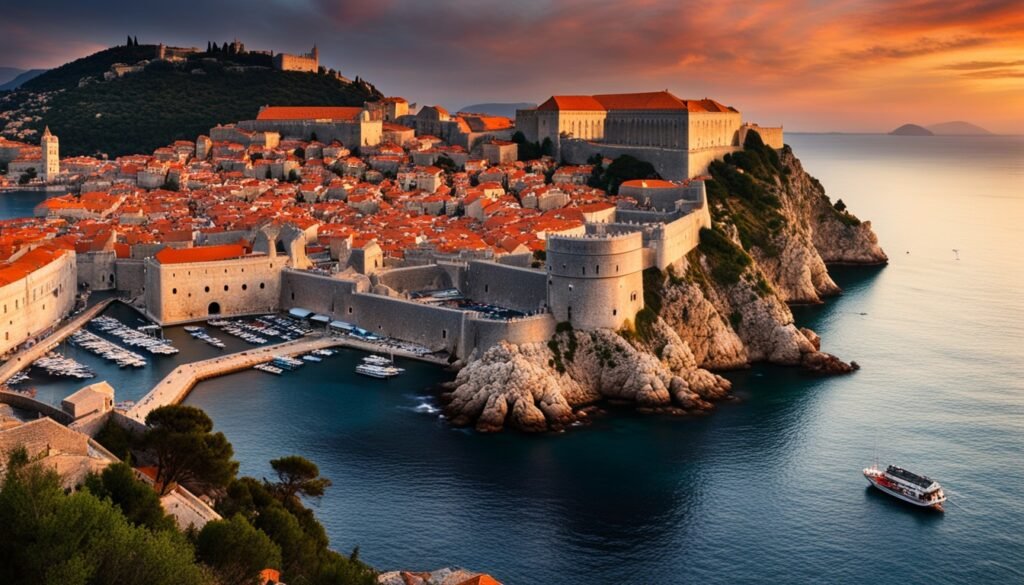There are over 1,100 UNESCO World Heritage Sites around the world. These places are as varied as they are stunning. You can visit the pyramids of Giza, the walled city of Carcassonne, Angkor Wat in Cambodia, or the Great Barrier Reef. Each site has a unique historical or natural value.
These sites show off humanity’s best cultural and natural treasures. You’ll find everything from medieval cities and Incan ruins to Buddhist temples and African national parks. My travels through these places highlight their uniqueness and beauty. They invite you to see the beauty they offer.
Key Takeaways
- Over 1,100 UNESCO World Heritage Sites worldwide.
- Incredible diversity, from the Great Wall of China to the Statue of Liberty.
- Sites embody significant cultural and natural heritage.
- The Great Barrier Reef is home to over 400 types of corals.
- Historic sites include medieval cities and ancient temples.
Discover the Mystique of Machu Picchu, Peru
Every year, millions of people visit Machu Picchu. They come for its ancient ruins and the history of the Incan civilization. This site, in the Andes Mountains, has been a UNESCO World Heritage Site since 1983. It shows the skill of the 15th-century Inca rulers.
Huayna Picchu and lush landscapes surround the site. It feels like a secret waiting to be found, even with many visitors.
The Historic Incan Ruins
Machu Picchu sits on a ridge above the Urubamba River valley. It’s a symbol of the Incan civilization’s stonework. Built in the 15th century, it has terraces, temples, and palaces that show their engineering skill.
There are three trains to get to Machu Picchu: Inca Rail, Peru Rail, and the Belmond Hiram Bingham train. For those who love adventure, the Inca Trail is a top choice. But it’s closed in February for maintenance. There are different tours available for every kind of traveler.
The Natural Beauty of the Andes
The trip to Machu Picchu is as stunning as the site itself. The area is covered in green hills, leading to the ancient ruins. The place is full of unique plants and animals.
Conservation is key to keeping Machu Picchu amazing for the future. Visitors love the natural beauty and the effort to protect it.
After visiting, check out Aguas Calientes, a town near Machu Picchu. It’s full of hidden spots along Av. Pachacutec. You can try Peru’s craft beer and enjoy local food. It’s a great way to relax after seeing the ruins and nature.
Unveiling the Ancient Temples of Bagan, Myanmar
In the heart of Myanmar lies the ancient city of Bagan, a place filled with Buddhist temples. These temples show centuries of history and art. UNESCO named Bagan a World Cultural Heritage Site on July 6, 2019, for its great importance.
Buddhist Art and Architecture
Bagan is home to over 2,000 temples and pagodas from the 11th to the 13th centuries. This site is a peak of Buddhist art and architecture. You’ll find beautiful frescoes and sculptures that tell Bagan’s story of growth.
The Ananda Temple, built in 1105 AD, stands out with its gilded Sikhara. It shines brightly at night. The Mahabodhi Temple, similar to its Indian counterpart, was restored after the 1975 earthquake.

The Famous Shwesandaw Pagoda
Visiting Bagan means seeing the Shwesandaw Pagoda. It’s famous for its stunning views at sunset. Climbing its steps gives you a view of the temples and the setting sun, showing Bagan’s beauty.
Every path provides a different perspective of this historic city.The best time to visit Bagan is from October to March, especially in January and February. You can explore by horse carriage, bicycle, or hot air balloon. Each way offers a unique view of this ancient city.
Marvel at the Grandeur of Angkor Wat, Cambodia
Angkor Wat is the top gem of Khmer architecture and a symbol of Cambodia’s pride. It was added to the World Heritage List in 1992. This massive site is the biggest religious monument in the world. It was first for Vishnu, then became a Buddhist temple. It covers about 402 acres and is part of a huge 99,000-acre complex, including forests.
Khmer Architecture
Angkor Wat shows the genius of the Khmer Empire in architecture. It took millions of sandstone blocks, each up to 1.5 tons, to build it. The walls feature over 2,000 Apsaras, or heavenly dancers, showing Khmer art at its best.
The temple’s design is perfectly symmetrical, with galleries, towers, and courtyards. This shows the Khmer Empire’s skill in building. The moat and water system helped the temple and the city, showing the Khmers’ smart use of nature.
The bas-reliefs tell stories of Hindu myths and history. They show amazing craftsmanship and detail.
The Religious Significance
Angkor Wat was originally a Hindu temple for Vishnu. Later, in the 14th or 15th century, it became a Buddhist site. This change brought new structures and changes to the bas-reliefs, showing Buddhist themes.
International groups, the Cambodian government, and UNESCO work to keep Angkor Wat safe. They aim to protect its history and culture. Finding a balance between tourism and respecting the site is key to its survival.
For first-time travelers, I suggest Travel Tips for First-Time Travelers. It offers great advice on planning trips, packing, and enjoying local cultures.
The Epic Beauty of the Great Barrier Reef, Australia
The Great Barrier Reef is a true gem of Australian heritage. It stretches over 2,300 kilometers along Australia’s northeast coast. This wonder is the world’s largest coral reef system, full of *natural wonders* and *marine biodiversity. It’s a sight you can see from space, and it’s a top spot for nature lovers and adventurers.

This vast reef system has about 900 islands, a haven for diverse marine life. It’s home to one-third of the world’s coral species and over 1,500 fish species. You can find up to 30 dolphin and whale species among the 411 coral types and other marine life.
The Great Barrier Reef is more than a pretty sight; it’s key to the local economy, adding $5–6 billion a year through tourism. Every year, 2 million visitors come to dive and snorkel in its pristine spots.
One of the reef’s highlights is the Whitsunday Islands, famous for Whitehaven Beach. This beach is known for its stunning beauty, where clear waters meet soft white sands. The reef also helps endangered sea turtles by providing them with places to nest and breed.
- Spanning over 2,300 kilometers along Australia’s northeast coast.
- Home to one-third of the world’s coral species and over 1,500 fish species.
- There are approximately 900 islands, including Green Island, with a 6,000-year history.
- Supporting 30 species of dolphins and whales and six types of marine turtles.
- Significant annual economic contributions through tourism ($5–6 billion).
- Stinger season runs from November to May with an abundance of jellyfish.
The Great Barrier Reef faces big threats from climate change and pollution, causing coral bleaching. The Australian government is working hard to protect and restore it. Their efforts aid in preserving the reef’s beauty so that future generations can continue to appreciate it as one of the Seven Natural Wonders of the World.
Visiting the Great Barrier Reef is more than exploring an underwater paradise. It’s a chance to connect with *Australian heritage*. Whether you dive into the marine life or just enjoy the views, the experience is deeply meaningful and unforgettable.
The Enchanting Old City of Dubrovnik, Croatia
Dubrovnik is known as the Pearl of the Adriatic. It’s a mix of historic landmarks and architectural wonders. Massive medieval walls encircle the Old City, which has been a UNESCO World Heritage Site since 1979. It draws in tourists with its history and beauty, making it a top spot for cruises and tours.

Walking the City Walls
Walking the city walls is a thrilling activity in Dubrovnik. These walls, built in the 16th century, show off the city’s medieval history. Visitors love the views of the historic streets and buildings from up high. About 70% of tourists say it’s a must-do.
Some suggest going at night to beat the crowds. This adds a magical touch to the experience.
Historic Streets and Architecture
Dubrovnik’s beauty goes beyond its walls. Its historic streets are filled with structures that tell stories of the past. After a big earthquake in 1667, the city was rebuilt in the Baroque style. This shows its long and rich history.
Places like Fort Lovrijenac and the Rector’s Palace highlight the city’s history. They are symbols of Dubrovnik’s lasting legacy.
- Dubrovnik’s foundation traces back to the 7th century
- It was classified as a UNESCO World Heritage Site in 1979
- Well-preserved Old Town completed in the 16th century
| Statistics | Details |
|---|---|
| Average User Review | 4.07 out of 5 |
| Visitor Crowd Experience | 50% feel it is overcrowded |
| Popular Tourist Activities | Walking the city walls, visiting historic churches, and exploring Fort Lovrijenac |
| Average Time Spent | 1-3 days |
| Cost of Entrance | 90 Kuna (approx. 12 EUR) |
Authentic Charm of Old Havana, Cuba
Walking through Old Havana is like stepping into a vibrant, living museum of Cuban history. The mix of neoclassical and Art Deco buildings shows the city’s rich past. It’s been a UNESCO World Heritage Site since 1982 and is known for its cobblestone streets and colorful buildings.

Colorful Facades and Historic Plazas
Old Havana’s colorful buildings and lively plazas are unforgettable. For over five hundred years, these spots have been key to Cuban life. The four main plazas tell stories of the city’s history, from military to trade.
Each plaza is full of life and history. They offer a peek into different parts of the city’s past. Whether it’s about the military, religion, business, or trade, each plaza has its own story.
Cultural Influence and Architectural Styles
The architecture in Old Havana is stunning. You’ll see everything from colonial fortresses to neoclassical and Art Deco buildings. These buildings show the area’s deep history and beauty.
The fortress, Castillo de la Real Fuerza, is now a museum. It’s filled with exhibits on navigation and has a tower called Torre de la Espera. Museums like the Museo Nacional de Historia Natural de Cuba add to the city’s cultural richness.
| Plazas and Landmarks | Significance |
|---|---|
| Plaza de Armas | Military and governance center |
| Plaza de la Catedral | Religious hub, featuring Havana’s famous cathedral |
| Plaza Vieja | Commercially vibrant with markets and cafes |
| Plaza de San Francisco de Asís | Trade and maritime activities |
| Castillo de la Real Fuerza | Colonial military fortress with historical exhibits |
The Unique Landscape of Danxia Landform, China
The Danxia Landform is a stunning geological wonder in China. It was named a UNESCO World Heritage Site in 2010. It shows off the beauty of China’s natural sites. The area includes six parts: Chishui, Taining, Langshan, Danxiashan, Longhushan, and Jianglangshan. These stretch over 1700 km in southeastern China, from Guizhou to Zhejiang.
This area is a feast for the eyes with its colorful mountains. They were made over 20 million years ago. The mountains are mostly red sandstone with minerals that add to their color. Forces like uplift, weathering, and erosion shaped these amazing features.
- Continental red terrigenous sedimentary beds
- Natural pillars, towers, ravines, and valleys
- Waterfalls and erosion landforms
The Danxia Landform is not just beautiful but also important for conservation. It has forests with over 400 species of plants and animals, many of which are rare or endangered. This shows how vital these mountains are for nature.
These red cliffs and rocks have changed over millions of years. Each part of the Danxia shows how the land has changed over time. For instance, the height varies greatly, from 48 meters to 1,730 meters.
The Danxia Landform covers 82,151 hectares and has buffer zones of 136,206 hectares. This protects the unique rocks and helps preserve their value for all to see.
Managing the Danxia Landform is a big task. It has national park and nature reserve status. Techniques like research and monitoring help protect these wonders.
In summary, the Danxia Landform is a key part of China’s natural heritage. Its colorful mountains and unique geology draw nature lovers and scientists from everywhere.
Top Cultural Heritage Sites Across Continents
The world is full of diverse ecosystems, each with sites of great cultural and natural importance. We’ll look at some UNESCO World Heritage Sites. They show their unique role in our global heritage and highlight iconic landmarks.
North America’s Canadian Rocky Mountain Parks
Canada’s Rocky Mountain Parks are a key example of conservation efforts. They feature stunning peaks, glaciers, and fossil sites. Added to the list in 1984, they show the Earth’s changing geology.
The parks are a mix of natural beauty and scientific heritage. They support many plant and animal species. It’s a place where nature and history come together.
Europe’s Carcassonne, France
Europe’s Carcassonne is a city in France that takes you back to the Middle Ages. Added in 1997, it has towers, chapels, and ramparts. It’s a symbol of history, architecture, and military skill.
The city’s heritage lets you travel through time. It’s filled with stories of knights and battles.
Africa’s Bwindi Impenetrable National Park
Africa’s Bwindi Impenetrable National Park is a treasure in conservation efforts. Added in 1994, it’s famous for its gorillas and biodiversity. Trekking here takes you through a dense forest full of life.
This park shows the importance of protecting nature. It highlights the need to keep our ecosystems diverse.
| Region | Heritage Sites | Cultural | Natural | Mixed |
|---|---|---|---|---|
| Africa | 149 | 98 | 39 | 12 |
| Asia and the Pacific | 275 | 166 | 82 | 27 |
| Arab States | 93 | 81 | 8 | 4 |
| Europe and North America | 528 | 441 | 66 | 21 |
| Latin America & the Caribbean | 178 | 147 | 34 | 13 |
Conclusion
Reflecting on our journey, the world’s cultural heritage sites show great diversity and richness. Sites like Machu Picchu and the Great Barrier Reef tell stories of human history and nature. They show us the beauty of our past and the need to protect it for the future.
These sites teach us more than just about beautiful views or old buildings. They remind us of our shared history and the importance of saving our cultural treasures. They inspire us to keep these places safe for those who come after us.
Looking at how we manage these sites, we see the power of community action. Experts and local people working together can make a big difference. The Open University shows us how important it is to work together to protect our heritage.
When we talk about saving heritage, we need to find a balance. We need good management, people involved, and awareness in the community. Places like Ethiopia show us how important it is to protect cultural sites during development. We can’t let cities, disasters, or forgetfulness erase our history.
My travels have taught me that visiting these places is more than just seeing new sights. It’s about being part of the effort to keep our cultural heritage alive. By visiting and caring for these sites, we help them continue to inspire and teach others.
FAQ
What are UNESCO World Heritage Sites?
The United Nations has designated certain locations as World Heritage Sites for their cultural or natural significance. They include historical sites, unique ecosystems, ancient ruins, and cultural landmarks.
What makes Machu Picchu a unique cultural heritage site?
Machu Picchu is famous for its Incan ruins and stunning natural setting in the Andes. Its beauty and the skill of 15th-century Incan builders make it special.
Why is Bagan in Myanmar significant?
Bagan has over 2,000 Buddhist temples, monasteries, and sculptures. It shows the rich Buddhist art and architecture of ancient Myanmar. The Shwesandaw Pagoda is famous for its sunset views.
What makes Angkor Wat a must-visit site?
Angkor Wat is the biggest religious monument in the world and a symbol of Cambodia. It was first for Vishnu, then became a Buddhist temple. It shows the area’s deep religious and artistic importance.
What is special about the Great Barrier Reef?
The Great Barrier Reef is the biggest living structure on Earth and a hotspot for marine life. It’s known for its clear diving and snorkeling, protecting many marine species and offering stunning underwater views.
What can I expect when visiting the Old City of Dubrovnik?
The Old City of Dubrovnik has well-kept medieval buildings and walls. Visitors can walk the 1.2-mile walls, explore historic streets, and see the beautiful Mediterranean city.
What makes Old Havana unique?
Old Havana is known for its lively, colorful buildings, historic squares, and mix of Neoclassical and Art Deco styles. It shows Cuba’s rich culture and urban life, making it a beautiful and historic place.
What are the distinctive features of the Danxia Landform in China?
The Danxia Landform is famous for its colorful mountains made of red sandstone and minerals. This beautiful landscape took 20 million years to form, showing China’s natural diversity.
What are some notable UNESCO World Heritage Sites across different continents?
Notable sites include North America’s Canadian Rocky Mountain Parks, with their vast landscapes and peaks. Europe’s Carcassonne shows medieval strength. Africa’s Bwindi Impenetrable National Park is great for gorilla trekking and is rich in biodiversity.


